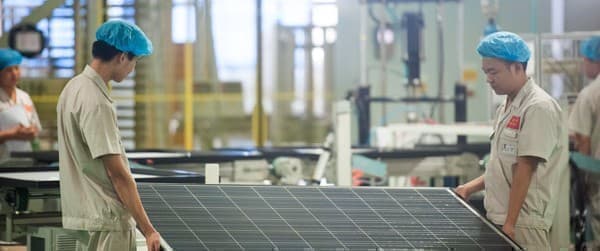There’s a new trend in solar energy projects, and it seems to be the staunch belief that bigger is better. As the pressure mounts around the world to decarbonize the global economy and cut back on greenhouse gas emissions, renewable energies like solar and wind have received more attention and investment than ever. As the world scales up its use of renewable energies, it makes sense, then, that the industry would also scale up the size of these solar and wind farms. That brings us to a new frontier in the solar energy industry, where the size of new solar projects has exploded.
“Large-scale solar projects are getting more common every year,” reports Bloomberg Green, a new platform that in itself reflects a changing energy and media landscape (the “new multiplatform editorial brand focused on climate change news, analysis, and solutions” debuted just last month). “In 2019, developers set a record by commissioning at least 35 projects of at least 200 megawatts worldwide, up about 17% from the year prior, according to an analysis of data compiled by BloombergNEF. With about 3,000 solar panels needed for each megawatt of capacity, a 200-megawatt project would be at least as big as 550 American football fields.”

This marks the beginning of a new era for solar, as it finally approaches a scale that could conceivably compete with the size and scale of traditional fossil fuels like oil, coal, and natural gas. This development is occurring (not coincidentally) in tandem with other key industry changes. One of which is consistently decreasing production costs of solar energy, which have plummeted in recent years. Setting these new developments against the United States’ legacy of small and expensive solar models, Bloomberg Green reports that “as equipment got cheaper, competition increased for long-term power-supply contracts with utilities, driving down electricity prices. Prices for the panels themselves have fallen about 88% in the last decade and are expected to fall another 43% by 2030, according to BNEF. That has put a premium on scale.” Related: Two Abundant Elements That Could Create A Superbattery
Another key development is the recent explosion of the energy storage industry, which allows variable energies like solar and wind, which depend on uncontrollable factors like weather and daylight hours, to supply steady energy flow to the grid by storing surplus energy during times of high production and distributing that energy later when the panels or turbines aren’t producing.
While the solar boom is growing, both in terms of the size of the sector as well as the size of individual projects and solar farms, some of the drawbacks are growing as well. The first problem with the huge projects is just that--they’re huge. While many people feel positively about the advancement of solar energy and renewable energy in general, few want a power plant of this scale anywhere near their backyard. And the problem is not just with NIMBYs.
After the spectacular failure of the SolarReserve Crescent Dunes project, earlier this month Oilprice went so far as to ask: “Are Large-Scale Solar Projects Doomed To Fail?” The Crescent Dunes project, a $1 billion solar plant in the middle of the Nevada desert somewhere in the no-man’s-land between Las Vegas and Reno, “was obsolete before it ever went online.” The scale and lumbering timeline of the mega-project made it unable to be flexible enough to keep up with the rapid development of solar technology. As the rest of the sector raced ahead, making a multitude of improvements to the industry standard, Crescent Dunes was simply left behind. Related: Nigeria’s Terrible Oil Decision
Happily, while the SolarReserve project lost its investors a whole lot of money, however, large-scale solar backers seem largely undeterred. As the cost of producing these kinds of solar projects continues to fall, Bloomberg Green reports that “there’s a growing group of buyers in the market for renewable assets, particularly pension funds and other institutional investors keen to match their long-dated liabilities with the consistent returns of solar farms.”
As massive solar projects become more common and more of the projects being kickstarted now come online over the next few years, solar energy will continue to get cheaper for consumers and will continue to become an ever-more viable replacement for fossil fuels. Despite some of the shortcomings of mass-scale solar, with catastrophic climate change just over the horizon, bigger really does seem to be better.
By Haley Zaremba for Oilprice.com
ADVERTISEMENT
More Top Reads From Oilprice.com:
- Saudi Arabia: OPEC Should Pay Serious Attention To Coronavirus
- Coronavirus Punches Hole In Oil Market That OPEC Can’t Fix
- Oil Tanks On Fears Of Global Economic Crisis



















But don't forget about the other way to talk about wind and solar: distributed generation (DG). That's where clean generation is located in closer proximity to the end-user. In many cases, this results in greater energy security and reliability, and less power-transmission loss.
Lot's of ways to string a power pole and do a power grid! Fuel your own electric vehicle!